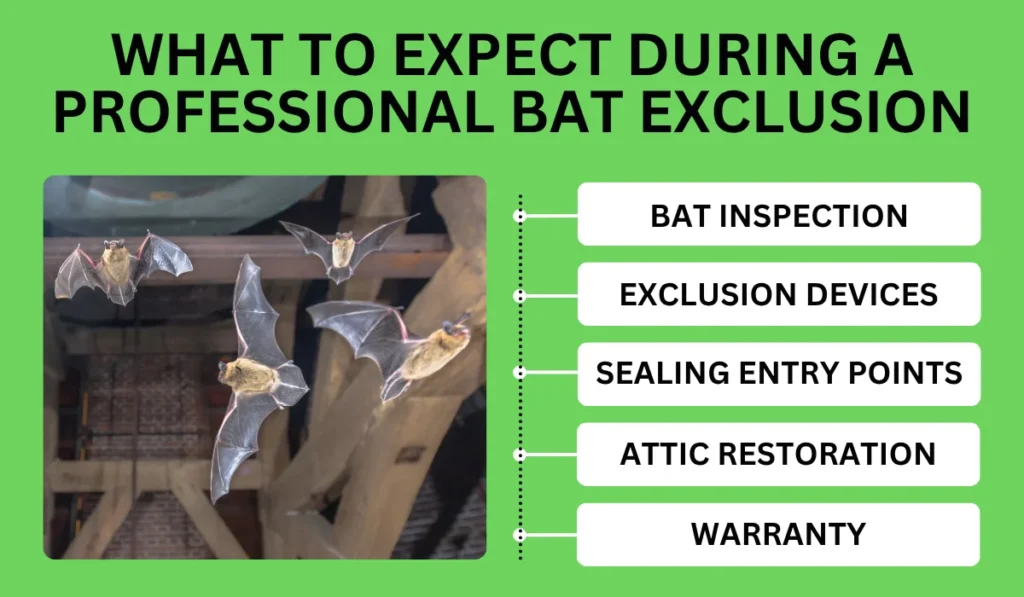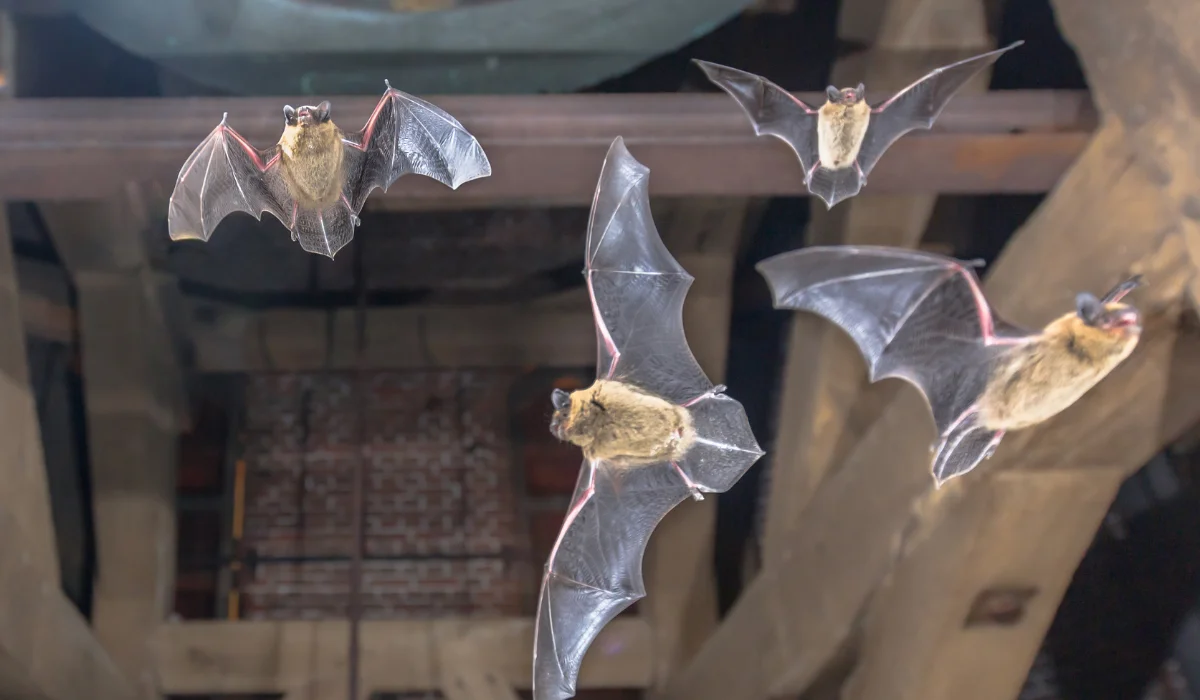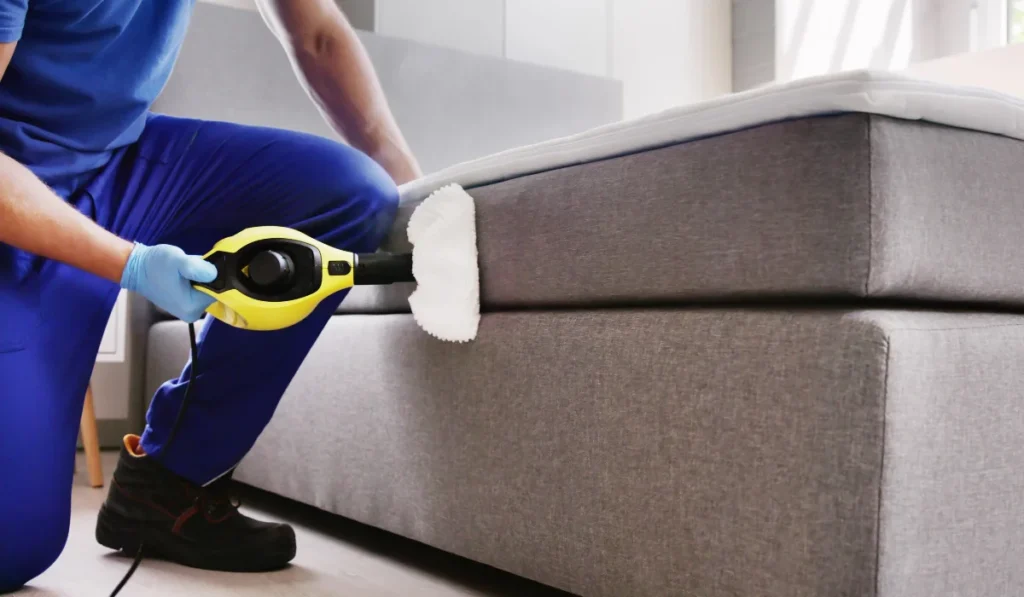Bats in your attic aren’t just annoying; they’re a sign that your home may have openings inviting wildlife inside.
In Michigan, attics provide an ideal roosting space, especially for species like little brown bats. While it may seem like a good idea to act right away, the most effective and humane method for dealing with bats is exclusion.
This article explains why live bat exclusion is the best method, how it works, and what to expect if you’re dealing with a bat problem in your Michigan home.
Key Takeaways
- Exclusion is the safest and most humane way to get rid of bats.
- Sealing up entry points is critical to long-term bat control.
- Michigan laws protect bats, so timing and methods matter.
- Attic restoration is often needed to clean up bat guano and damage.
Why Are There Bats in My Attic?
Michigan’s climate and insect populations make attics appealing to bats looking for a quiet, warm space to roost, especially during maternity season or hibernation. They often enter through small gaps in soffits, rooflines, ridge vents, or other openings along the exterior.
Once inside, bats don’t build nests. Instead, they cluster in colonies and leave behind piles of bat guano. If left untreated, guano can be harmful to your health and cause long-term damage to insulation and wood.
What Is Bat Exclusion?
Bat exclusion is a process that allows bats to leave your attic but blocks them from getting back in. Professionals use one-way doors or exclusion devices on active bat entry points to let bats out without letting them back in. These allow bats to exit naturally during their regular evening activity but prevent reentry.
This process allows bats to leave safely. It encourages them to find a new, more suitable home, ideally a bat house placed nearby.
Why Exclusion Beats DIY Bat Removal
Trying to get rid of bats yourself is risky and often ineffective. Here’s why you should leave bat exclusion to professionals:
- Legal protection: Many bats in Michigan, including little brown bats, are protected. It’s illegal to harm them or exclude them during maternity season when pups can’t fly.
- Timing matters: The exclusion process is only effective when bats can safely leave the attic. In Michigan, this is typically late summer or early fall, after pups have matured but before hibernation begins.
- Finding all entry points: Bats can slip through cracks just 3/8 of an inch wide. A complete inspection is the only way to see them all.
What to Expect During a Professional Bat Exclusion

When you hire a professional bat removal company like Pest Pros of Michigan, you’re getting a complete bat control solution, not just a quick fix. Here’s how the process usually works:
1. Bat inspection
A thorough inspection identifies where bats are entering, where the colony is roosting, and how much cleanup is needed. Technicians check rooflines, soffits, garages, and attic spaces for bat activity.
2. Exclusion devices
Technicians install one-way bat doors on active entry points. These devices remain in place for several nights to allow all bats to exit.
3. Sealing entry points
Once technicians confirm the bats are gone, they secure all access points and potential gaps using durable materials like caulk, screening, or metal flashing.
4. Attic restoration
If bats have lived in the attic for a while, attic restoration may be necessary. Restoration often involves removing contaminated insulation, cleaning up guano, and deodorizing the space to keep other critters from coming back.
5. Warranty
Reputable bat removal services typically offer a warranty for the exclusion work. At Pest Pros of Michigan, exclusions come with a full warranty and are backed by follow-up inspections if needed.
Why You Shouldn’t Use Repellents
Many homeowners ask if they can just use noise machines or repellents to scare off bats. The short answer? They don’t work. Bats are incredibly loyal to their roosting spots. Once they’ve chosen your attic, they’re unlikely to leave.
Plus, repellents do nothing to close off all gaps, so the bat problem comes right back.
A Better Solution: Bat-Proofing Your Home
After exclusion, preventing future infestations is key. That’s why it’s essential to seal up your home and make it bat-proof:
- Install screening over attic vents
- Seal gaps around chimneys, soffits, and rooflines
- Check garages and sheds for cracks or crevices
- Add a bat house on your property to give bats a safe alternative
Bats are typical across Michigan, and exclusion is often a seasonal necessity, not just a one-time fix.
Final Thoughts
Bats in your attic aren’t something to panic about, but you still need to deal with them the right way. Bat exclusion is the most humane, effective, and legal method of resolving a bat infestation in Michigan homes.
By working with a professional pest control company and sealing up every crack and opening, you can keep your home safe and bat-free long-term.
Whether you’re in Kalamazoo, Grand Rapids, or a neighboring town, Pest Pros of Michigan offers customized bat removal and exclusion services built for our climate and local bat populations.
Got signs of bats in the attic? Contact us today for a safe, effective solution. If you’re hearing fluttering in the attic or finding bat droppings, it’s time to act before the colony grows or damage worsens.
FAQs
How do bats get into my attic?
Bats find their way in through tiny gaps in vents, soffits, roof edges, and chimneys. A complete inspection can find all these spots and help prevent future entry.
What time of year is best for bat exclusion?
Late summer to early fall is ideal in Michigan, after young bats can fly but before cold weather sends them into hibernation.
Is bat exclusion safe and humane?
Yes. It uses one-way doors that let bats leave safely without letting them return. It’s the most responsible way to handle a bat problem.



